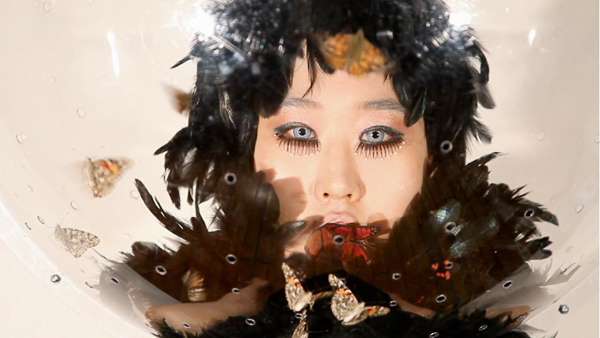
During the process of creating herwork, artist Lisa Park wanted to know how she could possibly make digital art that interacts with viewers on an intimate level.
The answer? Emotion.
On Wednesday, March 25, Park gave SUNY New Paltz a presentation of her unique take on a way to express her emotional states through the use of technology which is transformed into art.
“I use digital tools to decode and visualize my emotions,” Park said.
Park is an American-born and Korean-raised artist who is currently based in New York City. She has received her master’s degree in the Interactive Telecommunications Program from New York University. She has also recently been awarded the New York Foundation for the Arts Fellowship 2014 in the Digital/Electronic Arts category.
After giving a brief background of her studies, she explained how she uses technology to create performance-based installations.
Once she explored the possibilities of self-monitoring, she began to experiment with biosensors, which are devices that monitor heart rate and brainwaves to show a person their own physical and psychological states.
She uses these tools to better understand her inner state, feeling like she was making something externally representative of her inner emotions.
The first piece she showed the audience on screen was titled “Obsession is sad passion.”
In this installation, Park used a heart rate sensor, which affected the pitch of the sound of her voice in the background while narrating a story called “Depth Wish” that she recited in English and Korean.
Park’s head is enclosed in a plastic bubble as one of her most feared bugs – butterflies — fly around.
Next, Park showed a piece titled “Le violon d’lisa.”
In this piece, as stated on her website, thelisapark.com, “a nichrome wire attached on a cello bow is programmed to create sound when it touches a performer’s body.” When the bow comes in contact with skin, data is being collected then calibrated into sound.
This was an intimate experience for Park because she is not comfortable with exposing skin, especially in front of an audience.
“This piece made me feel vulnerable; I was going through a journey,” she said.
Park said that self-control is a reoccurring theme in her work.
“There is a conflict between desire to express self-control and emotion,” she added.
Park also spent an ample amount of time discussing an installation entitled “Eunoia.”
In this seven-to-10 minute installation, Park wears a headset EEG sensor that uses her brainwaves in real time to manipulate the motions of water.
Seated in the middle of five pools of water in customized metal dishes that are rested upon 15 inch speakers, Park meditates as the frequencies of her brain activity are being measured.
According to Park, she used five pools of water because they represented the five emotions of sadness, anger, desire, happiness and hatred.
This piece turned out to be ironic because Park used it as meditation as she went on a tour of herself, but people wanted to see more vibration.
Park then gave a live demonstration of how that headset works. She put the device on and with her laptop showed the activity of her brain at that moment.
“I’m at a meditative state,” she smiled.
First-year MFA sculpture major Amy Cunningham, enjoyed Park’s presentation.
“I found it interesting how she’s incorporating technology but the end result is very beautiful,” said Cunningham.
Park is currently working on an installation titled “Eudaimonia,” which translates to a state of happiness and development of a person in Greek.
After receiving hundreds of emails about people’s interest in the technology she uses in her art and people wanting to also get more in touch with their inner-self, she decided that this would be a participatory installation to explore the synchronization of brain activity of participants.
Park says this installation will answer questions she has pondered such as how different groups from various cultures, genders, ethnic and demographic backgrounds interact with one another and if emotions are universal.
“In all my pieces I try to overcome something that I always struggled with, so it’s like therapy for me,” Park said.
